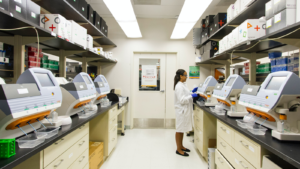
Sales and operations planning is a critical cornerstone of effective inventory management, but in healthcare, it’s a high-stakes game with no room for error. From life-saving medications to surgical supplies, the ability to anticipate demand and coordinate resources directly affects medical treatments, patient outcomes, and business operations. Despite this, many healthcare organizations still struggle with reactive planning, supply chain risk, and fragmented data. To keep pace with growing patient needs, operational pressures, and market challenges, decision-makers must rethink how they execute sales and operations planning in healthcare.
This article explores the state of S&OP in healthcare businesses, including the current challenges, and strategies that make planning smarter, faster, and more resilient.
The Unique Demands of Healthcare S&OP
Sales and operations planning (S&OP) is the structured process that helps organizations align supply, demand, and resources across departments. While it’s essential for all inventory-based businesses, it’s even more vital – and challenging – for healthcare organizations.
Why? When it comes to sales and operations planning in healthcare, the stakes are higher, the risks are greater, and the variables are more complex.
- Short product lifestyle and expiration constraints: Many healthcare products (such as pharmaceuticals, vaccines, and sterile supplies) have strict expiration dates. This means that overstocking can lead to costly waste – far more than is typical in other industries. S&OP must account for shelf life, usage rates, and replenishment timing with great precision.
- Life-critical and elective demand: Healthcare supply chains must support both emergency needs (like trauma kits and antibiotics) and elective procedures (such as orthopedic replacements). Each of these demand patterns require different forecasting and stocking strategies.
- Regulatory compliance pressure: Healthcare businesses and their supply chains are subject to intense oversights, from FDA regulations to regional standards. S&OP must include controls for things like traceability, documentation, and approved sourcing.
Along with these specifications, healthcare businesses must deal with the standard challenges of supply chain planning, such as supply shortages and delays. One study found that nearly 70% of providers said their teams spend 10+ hours per week mitigating supply chain challenges or shortages, and 40% have had to cancel or reschedule cases at least quarterly due to product shortages. Further data shows that in 2023 (the most recent year for which data is available) nearly 80% of all healthcare providers reported delays in receiving essential medical supplies, with disruptions costing the industry over $25 billion in unexpected and unnecessary expenses.
Strategies for Improving S&OP in Healthcare
While the challenges of sales and operations planning in healthcare are unavoidable, decision-makers can take steps to reduce their impact. Here are strategies you can use to ensure your healthcare business avoids waste, improves demand forecasting accuracy, meets compliance, and reduces the impact of risk.
1. Use advanced demand forecasting tools to inform demand planning
Accurate demand forecasts are essential for anticipating how much of each product you’ll need, whether that’s medication or surgical supplies. But instead of relying on manual methods or outdated forecasting systems, you can use modern demand forecasting technology to generate highly accurate forecasts, using a wide array of data sources. For example, today’s sophisticated tools take historical data, seasonality, and external data (such as health trends and regulatory changes) into account to help you predict how much of each item to order with greater confidence.
2. Leverage AI-powered S&OP tools
Artificial intelligence (AI) tools and features are transforming how healthcare businesses are approaching the S&OP process altogether. For example, inventory anomalies have historically thrown off forecast accuracy. But now, AI features have the ability to flag unusual or one-off sales for further investigation, with the option to exclude irrelevant outliers throwing off the forecast. This allows planning & procurement teams to flag unusual activity for discussion with sales or executive teams. Additionally, AI can monitor trends in customer purchasing behavior, and flag large orders that are delayed or overdue, to allow decision-makers to act proactively.
3. Segment inventory strategically
As we discussed, not all healthcare supplies and products are created equal. Some items are critical, and must always be in stock (like defibrillators and fast-acting inhalers) while others can tolerate longer lead times (like elective surgery kits). To plan effectively, businesses need to segment items based on what matters most to patient care and operational efficiency.
For example, you can categorize inventory based on whether it’s critical and high-velocity (blood bags, antibiotics), or elective and low-velocity (niche surgical tools). Use frameworks like ABC analysis to define how tightly each item should be controlled. Then, apply different planning strategies to each segment. Your most critical items might need buffer stock and multiple approved suppliers, while lower-priority items might benefit from just-in-time ordering.
4. Enhance visibility with technology and automation
In healthcare supply, limited visibility into inventory levels, demand signals, or supplier status can lead to delays, waste, and missed opportunities to optimize. Instead, leverage technology and automation to maximize inventory visibility, enable real-time decision-making, and ensure efficient patient care.
Start by centralizing your inventory data. Integrate your ERP system, inventory management solution, and supplier tracking portals into a unified planning environment to holistically monitor inventory, track usage, and align supply from a single source. Also, deploy real-time inventory tracking tools, such as IoT sensors, to achieve real-time visibility into stock levels – whether on hospital shelves, in transit, or at distribution centers. This level of granularity allows for faster replenishment decisions, better rotation of expiring stock, and fewer rush orders.
5. Create agile, scenario-based planning models
From sudden demand spikes during outbreaks to regulatory shifts which impact medication supply, healthcare organizations need to be ready to pivot on a dime. Instead of static planning models, use agile, scenario-based planning to explore different scenarios. For example, you can model a 20% increase in ICU admissions, delay in vaccine shipments, or recall of a critical medical device, and prepare actions in advance. Many advanced S&OP tools include scenario modeling features, which can simulate demand shifts, capacity constraints, or budget changes.
Improving sales and operations planning in healthcare is about more than just logistics: it’s about providing a high-quality patient experience, guaranteeing you have vital medical supplies, and ensuring care is never compromised by stock issues. From segmenting inventory based on clinical impact to integrating AI-powered demand forecasts, organizations that evolve their S&OP strategy will excel in both patient care and operational performance.
Achieve S&OP Excellence in Healthcare with StockIQ
Sales and operations planning in healthcare requires more than spreadsheets and legacy systems. Instead, you need advanced software which is specifically designed for healthcare businesses like yours to predict demand, segment inventory, monitor suppliers, and achieve end-to-end visibility. For that, you can turn to StockIQ.
StockIQ is a supply chain planning suite built for healthcare businesses like yours that taps into advanced technologies to help you streamline your S&OP processes. Our user-friendly system enables you to control inventory, simplify ordering, and enhance forecasting with AI-powered tools and sophisticated machine learning algorithms.
Are you interested in learning how StockIQ can help your healthcare business unlock the power of S&OP? Contact us today or request a StockIQ demo.

